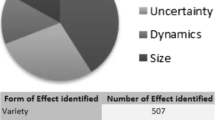Abstract
Remanufacturing can be regarded as a more sustainable way of manufacturing due to its economical and environmental benefits, compared to traditional manufacturing. Consequently, there is an ever increasing body of literature on remanufacturing, but there is still a lack of empirical data on it. This paper describes and analyses two Brazilian remanufacturing cases in the automotive industry. Based on them, some business issues are discussed, such as the quality of remanufactured products and the motivation for remanufacturing. Although it is not possible to make generalizations, both cases were not motivated by ecological reasons, but are derived from specific market niches.
Access this chapter
Tax calculation will be finalised at checkout
Purchases are for personal use only
Preview
Unable to display preview. Download preview PDF.
Similar content being viewed by others
REFERENCES
Guide, V. D. R. Jr.; Harrison, T. P.; Van Wassenhove; L. N.(2003): The Challenge of Closed-Loop Supply Chains, V. 33,N. 6, p. 3–6.
Jacobsson, N. (2000): Emerging Product Strategies: SellingServices of Remanufactured Products. Dissertation. The InternationalInstitute of Industrial Environmental Economics –Lund University, Sweden.
Steinhilper, I. R.; Brent, A. (2003): Saving Product Lives inGlobal and Local Remanufacturing Networks: A Scientific andCommercial Work Report and an Outlook. Third InternationalSymposium on Environmentally Conscious Design and InverseManufacturing. Tokyo, Japan.
Giuntini, R.; Gaudette, K. (2003): Remanufacturing: TheNext Great Opportunity for Boosting US Productivity. BusinessHorizons.
Barquet, A. P. B. (2010): Barreiras e Diretrizes para aImplementação de um Sistema de Remanufatura. 235f.Dissertation (Master on Prod. Eng.) – Curso de Pós-Graduação em Eng. De Produção, UFSC, Florianópolis.
Zanette, E. T. (2008): A Remanufatura No Brasil E NoMundo: Conceitos e Condicionantes. 2008. Monografia.Escola de Engenharia de São Carlos, Universidade De SãoPaulo, São Carlos, SP.
Zwolinski, P.; Lopez-Ontiverosa, M. A.; Brissaud,D. (2006): Integrated Design of Remanufacturable ProductsBased on Product Profiles. Journal of Cleaner Production,V. 14, p. 1333-1345[8] Ijomah, W.; Hammond, G.P.; Childe, S.J.; McMahon, C.A.(2005): A robust description and tool for remanufacturing: aresource and energy recovery strategy. In: Yamamoto, R.,Furukawa, Y., Koshibu, H., Eagan, P., Griese, H., Umeda, Y.,Aoyama, K., eds. Eco Design 2005. Proc. of the Fourth InternationalSymposium on Environmentally Conscious Designand Inverse Manufacturing. IEEE, pp. 472-479.
Ijomah, W. (2002): A model-based definition of the genericremanufacturing business process. Doctoral thesis, Universityof Plymouth.
Gray, C., Charter, M. (2006): Remanufacturing And ProductDesign: Designing For The 7th Generation, University CollegeFor The Creative Arts, Farnham, UK.
White, C. et al. (2003): Product Recovery With Some Byte:An Overview Of Management Challenges And EnvironmentalConsequences In Reverse Manufacturing For The ComputerIndustry. Journal of Cleaner Production, V. 14, p. 445-458.
Kerr, W.; Ryan, C. (2001): Eco-Efficiency Gains from Remanufacturing:A Case Study of Photocopier RemanufacturingAt Fuji Xerox Australia. Journal of Cleaner Production,V. 9, p. 75-81.
Steinhilper, R. (1998): Remanufacturing - The Ultimate Formof Recycling, Fraunhofer IRB. Verlag, Stuttgart.
Thierry, M.; Salomon, M.; Nunem, J.V.; Wassenhove, L.V.(1995): Strategic issues in product recovery management.California Management Review, vol.37, no.2, p.114-134.
Ijomah, W. L.; Childe, S.; Mcmahon, C. (2004): Remanufacturing:a key strategy for sustainable development.
Geyer, R.; Jackson, T. (2004): Supply Loops and their Constraints:The Industrial Ecology of Recycling and Reuse.California Management Review, V. 46, N. 2, p.55-73.
Ferguson, M. E.; Toktay L. B. (2004): The Effect of Competitionon Recovery Strategies. Technology and OperationsManagement, Insead,[18] EU, Directive 2002/96/EC of the European Parliament andthe Council of 27 Jan. 2003 on waste electrical and electronicequipment. Official Journal of the European Union.
EU, Directive 2000/53/EC of the European Parliamentand of the Council of 18 September 2000 on end-of life vehicles.Official Journal of the European Communities, (L269):p. 34-42.
Ostlin. J. (2005): Effectiveness in the Closed-Loop SupplyChain: A Study Regarding Remanufacturing, IEEE.
King, A. M.; Burguess, S. C. (2005): The Development of aRemanufacturing Platform Design: A Strategic Response tothe Directive on Waste Electrical and Electronic Equipment.Proc. Imeche Part B: Journal of Engineering Manufacture,V. 219, P. 623 – 631.
Parlikad A, McFarlane D. (2004): Recovering value from endof-life equipment—a case study on the role of product information.In: Technical report, centre for distributed automationand control. University of Cambridge.
Um, J.; Yoon, J.; Suh, S. (2008): An architecture design withdata model for product recovery management systems. In:Resources, Conservation and Recycling 52, p. 1175–1184.
Yin, R. K. (2005): Estudo De Caso: Planejamento E Métodos.3 Ed. Porto Alegre: Bookman.
Buxcley I. (2007): Remanufacturing in the Automotive Industry.Remediation for Remanufacture Seminar. Leeds.
Author information
Authors and Affiliations
Editor information
Editors and Affiliations
Rights and permissions
Copyright information
© 2011 Springer-Verlag Berlin Heidelberg
About this paper
Cite this paper
Oiko, O.T., Barquet, A.P.B., Ometto, A.R. (2011). Business Issues in Remanufacturing: Two Brazilian Cases in the Automotive Industry. In: Hesselbach, J., Herrmann, C. (eds) Glocalized Solutions for Sustainability in Manufacturing. Springer, Berlin, Heidelberg. https://doi.org/10.1007/978-3-642-19692-8_81
Download citation
DOI: https://doi.org/10.1007/978-3-642-19692-8_81
Published:
Publisher Name: Springer, Berlin, Heidelberg
Print ISBN: 978-3-642-19691-1
Online ISBN: 978-3-642-19692-8
eBook Packages: EngineeringEngineering (R0)




